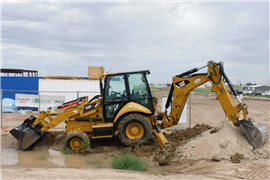A tale of two markets: Rental faces differing forecasts in US and Europe
28 May 2024
Recent regional reports paint very different pictures for US and European economies and their respective equipment rental markets this year. While the US is expecting more growth than originally predicted in the near term, the European market is expected to see less.
Forecasts for both markets were released over the past few weeks by leading industry authorities. Here’s a look at the highlights.
US growth exceeds expectations

The American Rental Association (ARA) updated its forecast released in February, with new predictions suggesting the US could reach $79.2 billion in rental revenue this year, a 2.8% jump from previous estimations which predicted a total of $77.3 billion.
Scott Hazelton, managing director, S&P Global, said about the update: “There has been no serious bust, thus, there is no serious boom. The outlook remains steady and inflation is falling,” noting that despite the jump this year, the pace og growth will cool a bit.
“Growth rates tail off in the future years, with growth of 3.8% in 2025 and 3.1% in 2026,” he said.
Elsewhere, Canada’s equipment rental revenue is projected to see 7.2% growth this year, totaling $5.79 billion.
General tool and construction and industrial equipment (CIE) are both expected to see growth, with general tool revenue projected to be up 6.8% to $1.08 billion, up from last quarter’s projection of $954 million.
General tool revenue is projected to increase 9.7% this year to $16.6 billion, and investment is expected to expand in 2024 and beyond.
Investment in general tool is projected to increase 7.3% with growth into 2025 at 7.9% and into 2026 at 6.4%.
Europe expects mixed results
Record numbers attended the ERA Convention in Lisbon, Portugal earlier this month to discuss the European rental sector’s future and more. One notable speaker, Martin Seban, director of KPMG, a global professional services firm providing audit, tax, and advisory services, presented an overview of the European rental industry’s current landscape and future outlook, noting downgraded
 Martin Seban, director of KPMG at the ERA Convention in Lisbon
Martin Seban, director of KPMG at the ERA Convention in Lisbon
forecasts in several countries.
In the UK, 2024 growth has been downgraded by 1.2% to 1.5%, and 2025 growth is expected to drop by 2% to 2.5%, Seban said.
For its part, Germany is now predicted to see 3% growth in 2025, down by 1.4% from earlier forecasts.
The Nordic region faces the biggest downgrades for 2025, with Norway down by 5.1%, Sweden by 2%, and Finland by 2.8%.
Meanwhile, Spain and Italy have maintained steady investment levels due to EU financial support, with projected growth of 5.5% and 3.5% respectively next year.
Seban noted that as the rental industry diversifies and targets new end markets, it becomes more connected to the global economy. He opened his presentation with a sobering statistic: After a post-Covid GDP growth of 6.2% in the Eurozone in 2021, the past two years saw more modest growth of 3.5% and 0.5%, respectively.
The outlook for the next 18 months is also uncertain, with forecasted growth of 1.3% for 2024 and 1.5% for 2025.
“Since 2023, we’ve seen a real slowdown in activity for various reasons, including inflation rates, which prompt central banks to raise interest rates, slowing the economy,” Seban said.
Despite these challenges, Seban highlighted some positives: “The NextGen EU program, which allocates up to €800 billion by 2027, is a significant opportunity. Based on the criteria, countries like Spain and Italy could see up to a 10% GDP boost from EU financial support, whereas Germany and France might see less than 2%.”
Construction trends drive rental growth across regions
Whichever market you look at, equipment rental continues to be driven by the health of construction, and many of the same drivers are providing tailwinds across regions.
In the US, rental is seeing a boon in rising infrastructure investment, increasing demand for housing, the boom in data center construction, among others, including a policy by President Joe Biden’s administration to bring semiconductor manufacturing back to the United States.
“Construction activity is one reason the Federal Reserve rate hikes have not brought the economy to its knees like the economic models from other business cycles had forecasted,” Christopher Rupkey, chief economist at FWDBONDS in New York, was quoted by Reuters.
“There’s money for new industrial building projects with the only risk being there is a severe nationwide shortage of construction workers.”
 Forecasts for equipment rental in the US and Europe show differing regional realities. (Image: Adobe Stock)
Forecasts for equipment rental in the US and Europe show differing regional realities. (Image: Adobe Stock)
In Europe, the construction industry shows a similar trend of downgraded growth as the region’s rental market. After a 5.3% recovery in 2021 and a 2.7% increase in 2022, this year is predicted to see a 2.1% decrease. Modest growth of 1.5% is expected by the end of 2025, however.
Seban noted macro-economic dynamics influencing the Eurozone, including:
- Ongoing energy market vulnerabilities, particularly in light of the geopolitical tensions in Ukraine and the Middle East.
- High interest rates and the tightening of monetary policies.
- Adverse developments in major trading partners such as China.
Concerns are particularly acute in the residential construction market, which accounts for an estimated 49% of construction activity in Europe.
KPMG has revised its outlook downward due to an “accentuated contraction of the new residential market,” leading to the lowest confidence in the sector since the pandemic began.
As of 2023, KPMG estimates that 65% of the equipment rental industry in Europe is linked to construction. Of this figure, 35% is either residential or non-residential construction (with civil engineering comprising the remaining 30%).
The slowdown in residential construction, declining customer confidence, and rising interest rates are thus significantly impacting the rental industry.
“Residential construction, in particular, is a significant portion of the business alongside non-residential, both suffering greatly and accounting for the major shifts in revenue generation across Europe,” Seban stated. “The impact varies by country due to market maturity and diversification, as well as the size of the construction segment.”
STAY CONNECTED



Receive the information you need when you need it through our world-leading magazines, newsletters and daily briefings.
CONNECT WITH THE TEAM













